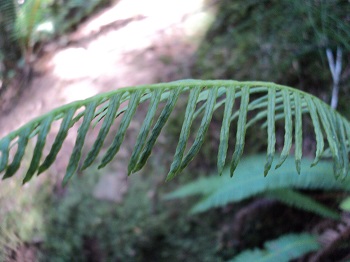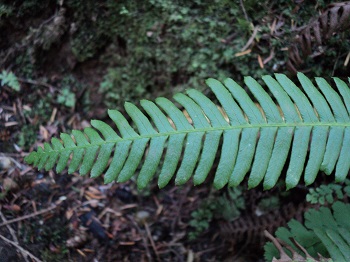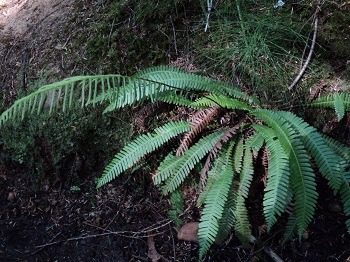


|
|
Practical ecological knowledge for the temperate reader. |
Family: Blechnaceae (Chain Fern family) [E-flora]
Other Names: Hard Fern. [PFAF]
Thiaminase Root, Shoots Bedding Material, Groundcover, Cooking pit liner Internally for Diarrhoea, Externally for sores
 |
|  |
"Blechnum spicant is an evergreen Fern growing to 0.3 m (1ft) by 0.3 m (1ft in) at a slow rate.
It is hardy to zone (UK) 5. It is in leaf 12-Jan, and the seeds ripen from Jun to August." [PFAF]
"Suitable for: light (sandy), medium (loamy) and heavy (clay) soils, prefers well-drained soil and can grow in heavy clay soil. Suitable pH: acid and neutral soils and can grow in very acid soils."
"It can grow in full shade (deep woodland) semi-shade (light woodland) or no shade. It prefers moist soil." [PFAF]
Origin Status: Native [E-flora]
Introduction:
"Deer fern is a perennial evergreen fern species that is circumpolar--although widely disjunct--in distribution (Douglas et al. 1998). In North America, it is found from Alaska south to Idaho and California. In British Columbia, it is abundant in coastal forests where it is found in "mesic to wet forests, peat bogs, streambanks and clearings in the lowland and montane zones" (Douglas et al. 1998). This species is widely used in coastal gardens."
"Deer fern has two types of fronds, vegetative and reproductive. The vegetative fronds form an attractive, evergreen rosette of broadly spreading, glossy fronds that hug the ground. Later in the season a set of finer textured, vertical, spore-bearing fronds arise from the centre of this rosette. BC is blessed with beautiful native ferns among which deer fern must surely be included. (Note Author: Gary Lewis, Phoenix Perennials)" [E-flora]
Synonyms
General:
"Tufted evergreen perennial from a short, thick rhizome." [IFBC-E-flora]
Leaves:
"Dimorphic; sterile leaves evergreen, spreading, lanceolate, 10-60 cm long, 2-10 cm wide, pinnately cleft (regularly deeply lobed); fertile leaves erect, narrowly lanceolate, 20-50 cm long, 1-pinnate with linear segments up to 7 cm long, 1-2 mm wide, withering soon after shedding spores." [IFBC-E-flora]
Notes:
"Our plants are generally more robust than their European counterpart and are referred by some authors (Love & Love 1966, 1968) to the amphiberingian ssp. nipponicum (Kunze) Love & Love." [IFBC-E-flora]
Habitat: "Mesic to wet forests, peat bogs, streambanks and clearings in the lowland and montane zones." [IFBC-E-flora]
"Woods, heaths, moors, mountain grassland and on rocks, to 1200 metres[17]." [PFAF]
Range: "common in coastal BC, infrequent in SE BC; circumpolar, but widely disjunct, N to AK and S to ID and CA; N Africa, Eurasia." [IFBC-E-flora]
"Most of Europe, including Britain, N. Africa, Japan, Western N. America." [PFAF]
Ecological Indicator
"A shade-tolerant, submontane to alpine, circumpolar fem distributed more in Pacific than Cordilleran North America. Occurs in hypermaritime to maritime subalpine boreal and summer-wet cool mesothermal climates on fresh to very moist, nitrogen-poor soils. Its occurrence decreases with increasing continentality (very frost-sensitive). Scattered to abundant (occasionally dominant) in old-growth coniferous forests on water-receiving sites; sporadic and less vigorous on water-collecting sites. Grows best on well decomposed (greasy) organic materials; on nutrient-rich soils, confined to decaying coniferous wood. Usually associated with Gaultheria shallon, Rhytidiadelphus loreus and Vaccinium alaskaense. An oxylophytic species characteristic of Mor humus forms." [IPBC-E-flora]
"The roots and leaves of the deer fern were eaten during food shortages by the Washington Salish (Gunther, 1945) but there is no direct evidence that they were used on the Island." [Turner&Bell1]
"Despite the distinctiveness of its fronds, Blechnum spicanthas been encountered only once in the folk use records—and that as merely one of eight ingredients in a juice drunk for a cough after a fever in Mayo....Though employed by midwives in the Faeroe Islands in the eighteenth century to staunch bleeding in childbirth,... it would appear not to have found favour in the British Isles, at least in more recent times, as a specific." [MPFT]
"A calcifuge plant[17], it prefers a moist shady nook in the rock garden or a position in open woodland in a moist soil[1]. Succeeds in quite dense tree shade if the soil is moist[200]. Prefers a moist position and a northerly aspect but succeeds in sun and in clay soils[1]. A polymorphic and very ornamental species[1], there are several named varieties[200]. Members of this genus are rarely if ever troubled by browsing deer[233]." [PFAF]
Propagation: "Spores - best sown as soon as they are ripe on the surface of a humus-rich sterilized soil. Keep the compost moist, preferably by putting a plastic bag over the pot. Pot on small clumps of plantlets as soon as they are large enough to handle and keep humid until they are well established. Overwinter for the first year in a greenhouse and plant outside in late spring or early summer. Division in spring or autumn. Larger divisions can be planted straight into their permanent positions whilst smaller clumps are best potted up and kept in a cold frame until they are growing away well." [PFAF]